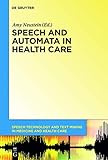Speech and Automata in Health Care / edited by Amy Neustein.
Material type: TextSeries: Speech technology and text mining in medicine and healthcareAnalytics: Show analyticsPublisher: Berlin ; München ; Boston : DE GRUYTER, 2014Edition: 2014Description: 1 online resourceContent type:
TextSeries: Speech technology and text mining in medicine and healthcareAnalytics: Show analyticsPublisher: Berlin ; München ; Boston : DE GRUYTER, 2014Edition: 2014Description: 1 online resourceContent type: - text
- computer
- online resource
- 9781614515159
- 1614515158
- Robotics in medicine
- Human-computer interaction
- User interfaces (Computer systems)
- Speech processing systems
- User-Computer Interface
- Robotique en médecine
- Interfaces utilisateurs (Informatique)
- Traitement automatique de la parole
- COMPUTERS -- Computer Literacy
- COMPUTERS -- Computer Science
- COMPUTERS -- Data Processing
- COMPUTERS -- Hardware -- General
- COMPUTERS -- Information Technology
- COMPUTERS -- Machine Theory
- COMPUTERS -- Reference
- Human-computer interaction
- Robotics in medicine
- Speech processing systems
- User interfaces (Computer systems)
- 004.01/9 23
- R857.R63
| Item type | Home library | Collection | Call number | Materials specified | Status | Date due | Barcode | |
|---|---|---|---|---|---|---|---|---|
 Electronic-Books
Electronic-Books
|
OPJGU Sonepat- Campus | E-Books EBSCO | Available |
Preface (including Acknowledgments); Editor's Introduction; List of authors; Part I. The evolution and design of service robots in health care: evaluating the role of speech and other modalities in human-robot interaction; 1. A critical analysis of speech-based interaction in healthcare robots: making a case for the increased use of speech in medical and assistive robots; 1.1 Introduction; 1.2 Background; 1.2.1 Robots and health care; 1.2.2 Speech- based interaction with machines; 1.2.3 Technologies for spoken interaction with machines.
1.3 Spoken interaction in healthcare robots -- a brief review1.3.1 Method; 1.3.2 Overview of results; 1.3.3 Findings; 1.4 Discussion; 1.4.1 Strengths; 1.4.2 Weaknesses; 1.4.3 Opportunities; 1.4.4 Threats; 1.5 Charting out a roadmap; 1.5.1 Future directions: a roadmap; 1.5.1.1 Evolution of speech and language technologies; 1.5.1.2 More natural spoken interaction; 1.5.1.3 Integrate into a multimodal interaction; 1.5.1.4 Connect robots to services supporting speech interaction; 1.5.1.5 Interaction design; 1.5.1.6 Reduce the gap between robotic technology, health care and the users.
1.5.2 ConclusionAcknowledgments; References; 2. Speech- based interaction with service robots: a survey of methods and approaches; 2.1 Introduction; 2.2 Methods and approaches; 2.2.1 Command interpretation; 2.2.1.1 Speech acts and probabilistic logic; 2.2.1.2 Semantics and pragmatics of pick-and-place tasks; 2.2.1.3 Interpretation of location and direction instructions; 2.2.1.4 Extraction of spatial description clauses from linguistic input; 2.2.1.5 Passive knowledge rarefication with direct memory access parsing; 2.2.2 Command disambiguation; 2.2.2.1 Template- based disambiguation.
2.2.2.2 Disambiguation through NP grounding2.2.2.3 Symbol grounding with probabilistic graphical models; 2.2.3 Dialogue with the user; 2.2.3.1 Spatial dialogue with 2D Sonar grid models; 2.2.3.2 Human- robot interaction through gesture- free spoken dialogue; 2.3 Talk the walk: robotic NLP vs. human sublanguage acquisition; 2.3.1 Interaction with bystanders; 2.3.2 Corpus- based robotics; 2.3.3 Sublanguage acquisition; 2.4 Discussion; 2.4.1 User command disambiguation; 2.4.2 User command disambiguation; 2.4.3 Dialogue with the user; 2.4.4 Sublanguage acquisition; References.
3. Improving patient-robot interaction in health care: service robot feature effects on patient acceptance and emotional responses3.1 Introduction; 3.1.1 Motivation; 3.1.2 Current state of PRI in healthcare-related tasks; 3.1.2.1 Telemedicine/Telepresence; 3.1.2.2 Intelligent walker; 3.1.2.3 Cognitive reminder; 3.1.2.4 Social interaction and therapy; 3.2 Design requirements and existing system guidelines; 3.2.1 Role of human emotion in acceptance of robots in healthcare applications; 3.2.1.1 Design of robot anthropomorphic features and effects on human responses.
<!Doctype html public ""-//w3c//dtd html 4.0 transitional//en""> <html><head> <meta content=""text/html; charset=iso-8859-1"" http-equiv=content-type> <meta name=generator content=""mshtml 8.00.6001.23532""></head> <body> Speech and automata in the healthcare environment provides information for the integration of embodied agents into the healthcare delivery system. </body></html>
eBooks on EBSCOhost EBSCO eBook Subscription Academic Collection - Worldwide
There are no comments on this title.

